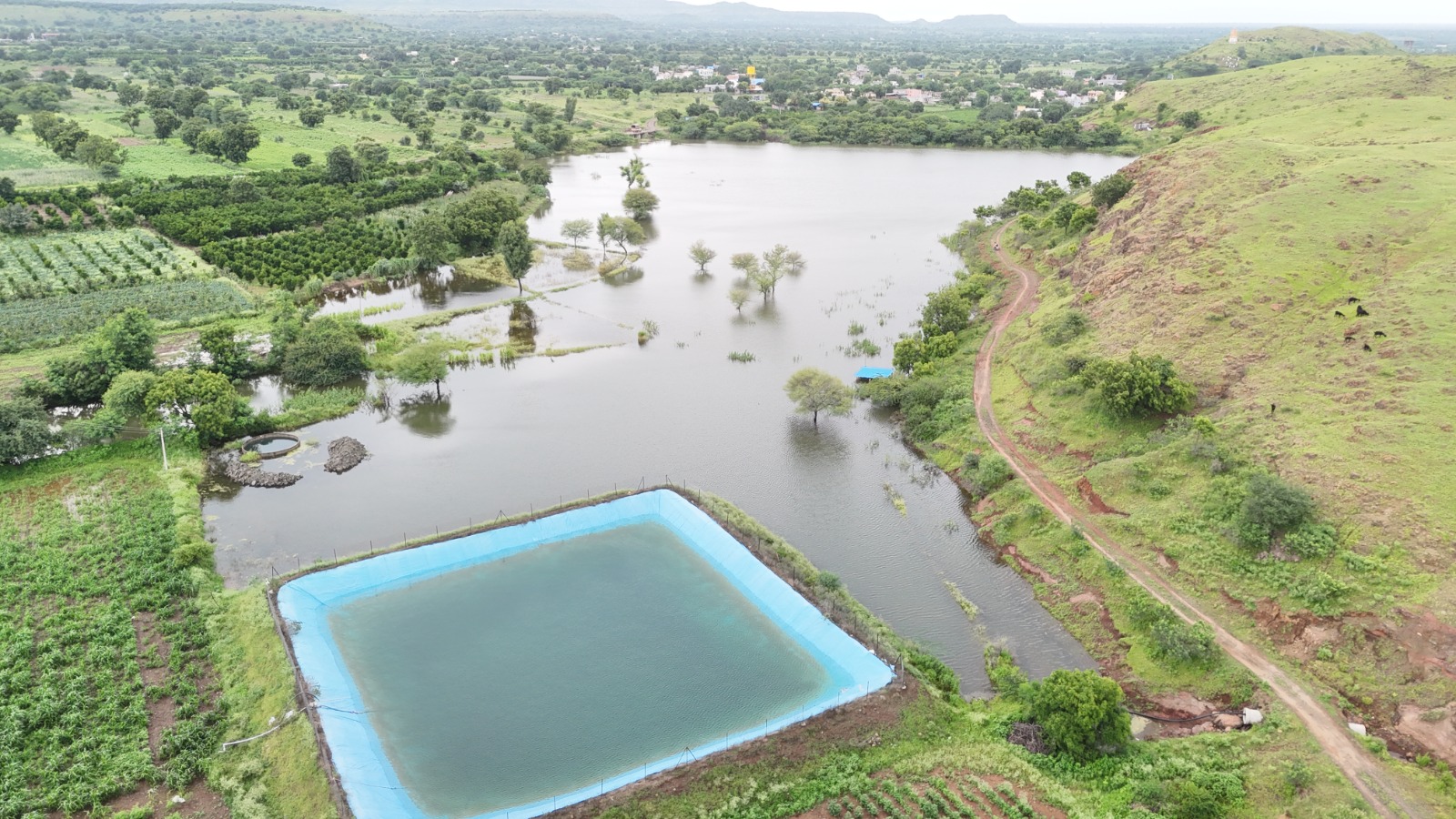TITLE: Galmukt
Dharan Galyukt Shivar
EXECUTIVE SUMMARY :
The Galmukt Dharan Galyukt Shivar Yojna, initiated by the Government of Maharashtra in 2017, is a transformative program aimed at addressing critical challenges in water conservation and rural development. This innovative initiative focuses on de-silting reservoirs to enhance their water storage capacity and utilizing the nutrient- rich silt to rejuvenate agricultural lands, thereby tackling water scarcity and declining soil fertility. To date, the program has removed 2345808 cubic meters of sediment, creating 2346 TMC (Thousand Million Cubic Meter) of additional water storage, ensuring reliable water availability for irrigation and drinking purposes. The initiative has yielded outstanding results, including improved soil fertility that boosts crop yields, active community participation fostering sustainable water management, and economic upliftment through increased agricultural productivity. Its unique Jan-bhagidari project (community-driven) approach empowers local stakeholders such as farmers, gram panchayats, and NGOs, ensuring ownership and widespread impact.This low-cost, high-impact model aligns perfectly with the principles of sustainable development demonstrating its scalability and replicability for other water-stressed regions.By revitalizing reservoirs and transforming farmlands, the program has profoundly improved rural livelihoods and ecological balance. The “Galmukt Dharan Galyukt Shivar Yojna” stands as a visionary blueprint for sustainable water resource management, making it an exemplary initiative deserving recognition and replication
PROBLEMS ADDRESSED :
1. Decreasing Water
Storage Capacity in Reservoirs: Silt accumulation in reservoirs reduces
capacity, impacting irrigation and drinking water. GSDA reports Ahilyanagar's
2022 groundwater dropped below average.
2. Erosion reduces soil
fertility, leaving land infertile. Desilting structures hold fertile soil, yet
it's underutilized for spreading, limiting land fertility improvement and
farmers' cultivation expansion.
3. Limited water and poor
soil increase costs and lower yields, deepening farmer poverty. Lack of
affordable silt limits soil enrichment and crop productivity improvement.
4. To address silting
issues and farmer demands, the department chose percolation tanks, K.T. Weirs,
and drains for desilting, involving NGOs and proactive Grampanchayats
5. Community
participation in water conservation significantly increased over two years,
enabling the department to select over 400 water bodies for desilting in
2025-26.
IMPORTANCE OF THE INITIATIVE:
Solving the water scarcity problem is crucial because access to clean and adequate water is a basic human need and fundamental right. In rural areas, the lack of proper water supply not only leads to daily hardships but also creates a cascading impact on health, education, and economic opportunities, particularly for women and girls. Women, who are the primary water collectors, spend hours every day walking long distances to fetch water. This time-consuming task affects their ability to participate in income-generating activities or community decision-making, while young girls often miss school, depriving them of education and future opportunities. Additionally, inadequate water access exacerbates health issues. Contaminated or insufficient water leads to waterborne diseases and poor hygiene practices, impacting entire communities. For farmers, unreliable water supply affects irrigation, reducing agricultural productivity and perpetuating cycles of poverty in rural areas. Resolving this issue would lead to multiple benefits, including improved health outcomes, better education for girls, and enhanced economic stability for rural families. Moreover, addressing water scarcity would empower women by reducing their daily burden and enabling them to actively contribute to community development. Ensuring sustainable and clean water access is not just a necessity—it is a transformative step toward social and economic equality, rural upliftment, and long-term environmental sustainable.
BENEFICIARIES OF THE PROJECT:
No. of Internal Beneficiaries: 40
No. of External Beneficiaries: 27000
OVERVIEW AND TIMELINE OF KEY EVENTS:
The Government of Maharashtra recognized the pressing challenges of water storage and soil degradation in rural areas, prompting the launch of a comprehensive water conservation and rural development scheme in 2017. This initiative aimed to enhance water availability and restore soil health in rural communities through strategic water body management and soil enrichment.In 2023-24, the program focused on selecting 41 reservoirs, such as Paazar Talav and Kolhapur-type Bandhara, from various talukas. During this phase, 189,165 cubic meters of sediment were removed, which helped create an additional 189 TMC (Thousand Million Cubic Meters) of water storage. Building on this success, the program expanded in 2024-25, selecting 114 water bodies and removing 2,156,643 cubic meters of sediment, resulting in an additional 2,157 TMC of water storage capacity. The goal for 2025-26 is to target over 400 water bodies for desilting perations to further increase water availability. De-silting operations were carried out with the involvement of NGOs and Grampanchayats, using machinery like JCBs and Poclains. In 2024, the Chandra Foundation committee from Mantralaya visited two water bodies in Kalkup Village, Parner Taluka, to monitor the progress of the desilting work. In addition to water storage improvements, the program facilitated the distribution of the removed silt to farmers. In 2023-24 and 2024-25, more than 5,850 acres of farmland benefited from the silt, enhancing soil fertility and boosting agricultural productivity. This scheme has proven vital in improving both water conservation and agricultural practices in rural Maharashtra.
KEY OBJECTIVES, GOALS, AND TARGETS OF THE
PROJECT:
1. The program selected 41 water bodies in 2023-24, removing 189,165
cubic meters of sediment, and 114 in 2024-25,enhancing water storage by 2,157
TMC
2. Desilting of percolation tanks, K.T. Weirs, and nalla restoration in
Ahilyanagar district ensured water availability for the 2024-25 Rabi season,
boosting crop cultivation areas.
3. Engage local communities, gram panchayats, and self-help groups (NGOs)
in water conservation to promote ownership,accountability, and sustainable
management of water resources for long-term success.
4.
In this year 2025-26 this program targeted more than 400 water bodies
of our department for desilting.
PROCESS
FOLLOWED FOR DEPLOYMENT OF THE PROJECT:
1. In 2023-24, B.J.S. implemented awareness programs for Galmukt Dharan
Galyukt Shivar Yojna, selecting water bodies through Grampanchayat resolutions
and organizing meetings at the collector office.
2. District Collectors select NGOs based on document verification and
need. In 2023-24 and 2024-25, seven NGOs were chosen to participate in water
conservation efforts
3. The A.T.E. Chandra Foundation and Soil and Water Conservation
Department developed the AVNI Gramin App, used for water body registration,
work orders, and daily reporting by NGOs and Grampanchayats
CHALLENGES FACED DURING IMPLEMENTATION OF THE
PROJECT
1.
Land Enchronchment
problems done by farmers are faced during exacavation
2.
Silt Distribution among
farmers is a major task during implementation
3.
Earthmoving machinery and
transportation vehicles are not regularly working at some site due to this it
is time consuming for working.
4. Site inspections should
be conducted regularly by the Site Engineer. Measurements must be taken
simultaneously by both the Site Engineer and NGO engineer for accuracy
5. Government departments
complete on-time observation reports, while maintaining daily records proves
challenging for NGOs and Grampanchayats due to the volume and consistency
required.
SPECIFIC SOLUTIONs FOR THE PROJECT
1.
Water Storage Enhancement: The de-silting of reservoirs directly addresses the
problem of reduced water storage capacity due to silt accumulation, ensuring
better water availability for irrigation and drinking purposes.
2.
The removed silt, rich in organic matter and nutrients, serves as a natural
fertilizer for farmlands, reducing farmer’s dependency on chemical inputs and
enhancing crop productivity.
3.
The solution avoided the use of harmful chemicals or non-renewable resources,
aligning with sustainable development goals.
4.
Recharging of existing drinking water supply sources – Water supply schemes
functioning during summer time helps the women, who are the primary water
collectors, spend hours very day walking
long distances to fetch water. This time-consuming task affects their ability
to participate in income-generating activities or community decision-making,
while young girls often miss school, depriving them of education and future
opportunities.
5.
Resolving this issue would lead to multiple benefits, including improved health
outcomes, better education for girls, and enhanced economic stability for rural
families.
6.
Moreover, addressing water scarcity would empower women by reducing their daily
burden and enabling them to actively contribute to community development.
Ensuring sustainable and clean water access is not just a necessity—it is a
transformative step toward social and economic equality, rural upliftment, and
long-term environmental sustainable
KEY RESULTS & OUTCOMES OF THE PROJECT
1. In 2023-24, 41 water bodies were selected, removing 189,165 cubic
meters of sediment, creating 189 TMC. In 2024-25, 114 bodies removed 2,156,643
cubic meters, adding 2,157 TMC.
2. Silt distribution enhanced soil fertility,
increasing crop productivity by 15-20%, especially in sugarcane, paddy, and
vegetables. Farmers reduced input costs by 10-25% using silt instead of
chemical fertilizers.
3. Higher crop yields and lower input costs
boosted farmer income, improving economic stability. De-silting operations also
created thousands of temporary jobs, enhancing rural livelihoods.
4. The GSDA report shows that the groundwater
level in Ahilyanagar district increased by 0.75M in 2024 compared to the
average October levels of the past five years.
SCALABILITY OF THE PROJECT:
1. Department plan for this
year 2025-26 is this programme targeted more than 400 water bodies of our
department for desilting from different Talukas and to treat all the
percolation tanks in the district to restore capacity of water holding.
2.
Observation is that
comparing last year this time there is more NGOs and grampanchyats are taking
initiative for working.
3. After coordinating with
agriculture department the report shows good process in crop productivity as
well as crop rotation pattern by farmers.
4.
Future plan is to create
more awareness among farmers for crop rotation pattern to enhance ECONOMY as
well as lives .
5.
More focus on Soil
Fertility Enhancement and Water Storage Capacity
REFLECTIONS OR LESSONS LEARNT:
1.
Community Engagement is Key: The success of water
conservation programs depends heavily on active community involvement. When
local communities are involved in planning, implementation, and monitoring,
there is a greater sense of
ownership,
which leads to better sustainability and impact.
2.
Collaboration Between Government and NGOs:
Programs that see active collaboration between governmental agencies and NGOs
tend to be more successful.
3.
GSDA Report: According to GSDA report the ground
water level of Ahilyanagar district on an average has increased by 0.75M for
the year 2024 as compare to average water level in the month of October for the
last 5 years.
4.
Sustainability Over Time: For water conservation
efforts to be truly sustainable, they must incorporate long-term planning, such
as creating regular awareness programs and ensuring periodic maintenance of
water structures.
5.
Role of Technology: Innovative approaches,
including the use of technology for better monitoring, early warning systems
for droughts, and data-driven decision-making, can significantly enhance the
effectiveness of water management strategies.
6.
Economic and Social Benefits: Beyond the environmental
benefits, successful water conservation schemes can lead to increased
agricultural productivity, improved livelihoods for local farmers, and reduced
migration due to drought conditions.
7.
Integration of Traditional Knowledge:
Often, traditional water management practices (such as rainwater harvesting and
community-based water sharing systems) can complement modern techniques and
lead to a more culturally sensitive and locally accepted approach.




Comments 0 Like 0 Dislike 0